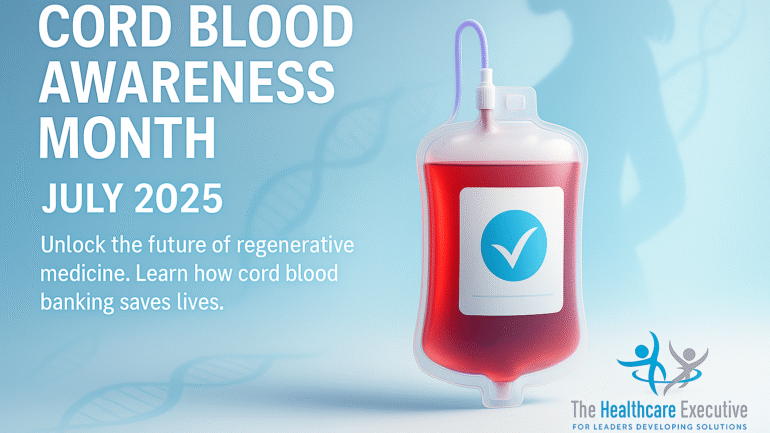Cord Blood Awareness Month – July 2025

- Posted by Greg Wahlstrom, MBA, HCM
- Posted in Health Observance Calendar
Hospital Leadership in Advancing Regenerative Medicine
Published: July 01, 2025
Each July, Cord Blood Awareness Month raises public awareness about the lifesaving potential stored in a newborn’s umbilical cord blood. Cord blood contains powerful stem cells that can treat more than 80 different diseases, including blood cancers, immune disorders, and genetic conditions. Hospitals and healthcare systems are instrumental in educating expectant parents about cord blood banking and donation. As highlighted in our Health Observance Calendar, observances like Cord Blood Awareness Month offer hospital leaders an important opportunity to review policies and enhance patient education strategies. Cord blood collection is a safe, simple procedure performed immediately after birth, posing no risk to mother or baby. Healthcare executives can ensure that information about public donation and private banking options is accessible and culturally sensitive. Raising awareness helps families make informed decisions that could save lives in the future. Hospitals are uniquely positioned to lead these conversations and integrate cord blood education into prenatal care. The Healthcare Executive remains committed to supporting hospital leaders in advancing regenerative medicine and patient-centered care.
Cord blood banking is increasingly viewed as an investment in future health, offering a potential lifeline for patients who may need stem cell transplants. Hospital-based programs are essential to facilitate the collection, storage, and use of cord blood units for both public and private purposes. Cord Blood Awareness Month reminds healthcare organizations to evaluate how effectively they communicate the benefits and limitations of cord blood banking. While private banking allows families to store cord blood for personal use, public donation helps expand registries that serve patients worldwide. Hospitals can collaborate with organizations such as the National Marrow Donor Program (Be The Match) and Parent’s Guide to Cord Blood Foundation to promote public donation and increase availability of matched stem cells for transplantation. Early counseling during prenatal visits is critical to ensure families have time to consider their options. By leveraging patient education materials, multilingual resources, and community partnerships, hospital leaders can help eliminate disparities in awareness and access. Cord Blood Awareness Month is an opportunity for hospitals to reaffirm their commitment to equitable, evidence-based care and innovative treatment options for future generations.
Beyond treating blood disorders, research into cord blood stem cells is unlocking new frontiers in regenerative medicine. Clinical trials are exploring the potential of cord blood to treat cerebral palsy, autism, and other neurological conditions. Hospitals with advanced research programs are at the forefront of integrating these breakthroughs into clinical care. As Sun et al. (2024) note, “Several clinical trials have evaluated the safety and efficacy of autologous or allogenic UCB infusion for neurological disorders such as cerebral palsy and autism spectrum disorder” (p.78). Cord Blood Awareness Month encourages healthcare leaders to support ongoing research collaborations and consider how emerging therapies may fit into strategic planning and resource allocation. While some experimental applications are still years away from standard use, the field of regenerative medicine continues to grow rapidly. As Sugarman et al. (2011) note, “most potential applications of UCB-derived cells remain theoretical or experimental and are not yet clinically proven.” Hospitals contribute significantly to educating families about current realities versus future possibilities to help manage expectations. By integrating cord blood discussions into prenatal classes and digital health platforms, they ensure consistent messaging and patient engagement. The Healthcare Executive emphasizes that clear communication is essential to avoid misinformation and foster trust between patients and providers. Cord Blood Awareness Month signals the importance of hospital leadership in balancing hope and science responsibly. Hospitals that invest in education and innovation position themselves as leaders in transformative care.
Equity in cord blood awareness and access remains a significant challenge. Studies show that minority populations are underrepresented even in public cord blood registries, making it harder for patients from diverse backgrounds to find matched stem cell donors. Hospitals can help close this gap by tailoring educational outreach to communities that have historically lacked information about cord blood banking and donation. Cord Blood Awareness Month serves as a call to action for hospital leaders to evaluate diversity and inclusion efforts in maternal health programs. Collaborating with community organizations, faith-based groups, and culturally competent care teams can help hospitals reach broader audiences and reduce disparities. Hospitals can also advocate for public policies that support funding for public cord blood banks and donor recruitment initiatives. As Butler et al. (2024) note, “Efforts to promote equitable cord blood banking must include policy advocacy, funding initiatives, and culturally tailored education to ensure diverse communities are informed and engaged.” By embedding equity principles into cord blood education, hospitals ensure that all families, regardless of socioeconomic status or ethnicity, have access to lifesaving information and options. The Healthcare Executive urges leaders to explore how policy and hospital strategy can drive health equity and innovation in regenerative medicine. Cord Blood Awareness Month reinforces hospitals’ collective responsibility to promote accessible, evidence-based care for all patients.
As Cord Blood Awareness Month unfolds this July, The Healthcare Executive celebrates the hospitals and healthcare professionals leading the way in regenerative medicine. From expanding public cord blood registries to fostering innovative research, hospitals are essential in creating a future where stem cell therapies save and improve lives. As Stephens (2017) notes, “Public cord blood banks are positioned as infrastructures that create biovalue for society by providing stem cells for therapy and as material for future regenerative medicine.” This observance is not just about medical science; it’s about empowering families with information and choices that can shape health outcomes for generations. Hospital executives are central in driving these efforts forward through policy development, staff training, and community partnerships. Cord Blood Awareness Month is a moment to evaluate progress and identify new opportunities for growth and impact. The Healthcare Executive remains committed to providing resources and insights that support hospital leaders navigating the complex landscape of regenerative medicine. Together, we can ensure that every family has the knowledge they need to make informed decisions about cord blood banking and donation. Let’s honor Cord Blood Awareness Month by building a future rooted in innovation, compassion, and equitable healthcare leadership.
Discover More
For more information, visit our Health Observance Calendar and explore national resources from the Parent’s Guide to Cord Blood Foundation and Be The Match. Together, we can advance equitable care and empower families with lifesaving knowledge.
Internal Resources
- The Healthcare Executive. (2025). Health observance calendar. The Healthcare Executive. https://www.thehealthcareexecutive.net/category/health-observance-calendar/
- The Healthcare Executive. (2024). Mastering healthcare financial management in 2024: Strategies for success. The Healthcare Executive. https://www.thehealthcareexecutive.net/article/mastering-healthcare-financial-management-in-2024-strategies-for-success/
- The Healthcare Executive. (2025). The Healthcare Executive homepage. The Healthcare Executive. https://www.thehealthcareexecutive.net/
External Resources
- Parent’s Guide to Cord Blood Foundation. (n.d.). Parent’s guide to cord blood. Parent’s Guide to Cord Blood Foundation. https://parentsguidecordblood.org/en
- Be The Match. (n.d.). National marrow donor program. Be The Match. https://bethematch.org/
- Association of Women’s Health, Obstetric and Neonatal Nurses. (n.d.). Umbilical cord blood: Information for childbirth educators. AWHONN. https://www.jognn.org/article/S0884-2175(15)30721-0/fulltext
- Sun, J., Zhang, X., Li, H., Wang, L., & Zhou, Y. (2024). Umbilical cord blood therapy for cerebral palsy and autism spectrum disorder: An update. World Journal of Stem Cells, 16(4), 78–91. https://www.ncbi.nlm.nih.gov/pmc/articles/PMC11287950/
- Sugarman, J., Kaalund, V., Kodish, E., Reich, W., Friedman Ross, L., & Sade, R. M. (2011). Umbilical cord blood banking for potential future transplantation or regenerative medicine applications. Obstetrics & Gynecology, 117(4), 949–954. https://www.ncbi.nlm.nih.gov/pmc/articles/PMC3209739/
- Butler, T. R., Singh, M., Alvarez, L., Chen, J., & Jones, S. M. (2024). Racial and ethnic disparities in umbilical cord blood banking and transplantation: Current landscape and strategies for equity. Transfusion Medicine Reviews. Advance online publication. https://www.ncbi.nlm.nih.gov/pmc/articles/PMC11456975/
- Stephens, N. (2017). Cord blood banking: Bio-objectification, policy and biovalue. New Genetics and Society, 36(1), 1–17. https://doi.org/10.1080/14636778.2016.1209106



